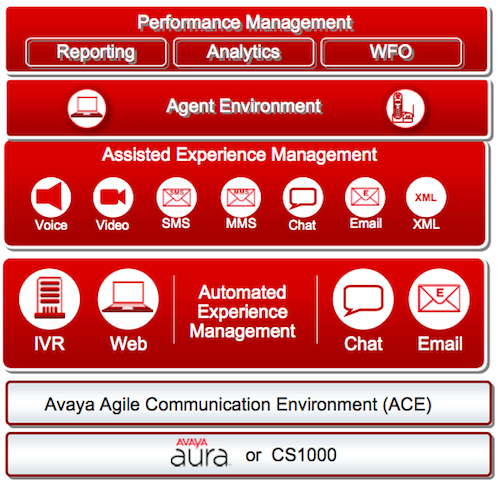 Avaya displays some very deft touches as it launched the next phases in its efforts to support transformational efforts of its enterprise contact center customers and prospects. The company is grappling with fundamental changes in how network based commerce is carried out; while, at the same time it is rationalizing and simplifying a portfolio of products and services that leverages the installed base of Avaya-branded platforms and software, Nortel’s legacy systems and services and a greenfield of multi-site, multi-vendor enterprise IT environments.
Avaya displays some very deft touches as it launched the next phases in its efforts to support transformational efforts of its enterprise contact center customers and prospects. The company is grappling with fundamental changes in how network based commerce is carried out; while, at the same time it is rationalizing and simplifying a portfolio of products and services that leverages the installed base of Avaya-branded platforms and software, Nortel’s legacy systems and services and a greenfield of multi-site, multi-vendor enterprise IT environments.
The corresponding transformation of Avaya’s contact center portfolio begins today with the introduction of five new products or major updates, including: two flavors of contact center to support “experience management”; two new “performance solutions” including IQ 5.1 for reporting and analytics across multiple channels and agent activities and a major update of Avaya Workforce Optimization (WFO); and a new application called Proactive Outreach Manager 2.0 which is part of Avaya’s Automated Experience Management Suite.
The new approach was described to analysts by Jorge Blanco, Avaya’s VP Product Marketing-Contact Center Solutions. He sees the core Contact Center Suite as a “multimedia work assignment engine”. Its components and architecture are depicted in this diagram:
Over the next 10 months, Blanco promises a rapid succession of product refinements and announcements. The result will be software, services and platforms designed to “orchestrate the user experience” across multiple channels, culminating in the introduction of the full-fledged Avaya Experience Manager in May 2011. At that point, the venerable Voice Portal will be supplanted by the next-generation Avaya Experience Portal as the contact center fulfills its role as an “Experience Center.”
Blanco explained that the product introduction strategy is predicated on the idea that managing the user experience is paramount and it is dependent on four major factors: orchestrating the user experience, applying real time data to support contextual or “purpose driven” collaboration, establishing the “full context” of a contact (so that data isn’t lost), and bringing live agents into the experience in order to accomplish “first session resolution” of a customer’s concern.
This sounds like a lot to accomplish, but Blanco asserts that the solutions that Avaya is introducing will not result in a forced migration to a complex set of products and services. Instead, as he put it, “We will have a complete, easier to sell portfolio when we’re done.” Acknowledging that Avaya’s Professional Services group has a major role to play, Ajay Kapoor, Managing Director, Strategic Communications Consulting, provided an overview of the support services that Avaya will bring to bear to make the fundamental transformation take place.
Avaya has a team of approximately 1,300 professionals comprising its professional services group. Traditionally, these were communications professionals, but the company it is in the process of changing the teams mix and chemistry to put greater emphasis on the business operations and front-end tasks like discovery, requirement design and defining what it takes to “get started” on business transformation.
One element of the Professional Services offering that will be especially important comes under the banner of “Assurance”. It includes “stress testing” and “readiness testing” based on simulation of real call traffic and customer activity in advance of bringing a new system, feature or service online. As companies grow more ambitious in their efforts to provide multichannel, multimodal and context-sensitive customer service, “assurance services” will be a necessity. Such confidence-building, risk reduction activity should provide enterprise decisionmakers the confidence they need to deploy new technologies that ensure a better user experience.
Categories: Articles


 NiCE Interactions 2025: Agentic AI, Better Data, and a Whole Lot of Partnership
NiCE Interactions 2025: Agentic AI, Better Data, and a Whole Lot of Partnership  Getting It Right: What AI Agents Actually Mean for Customer Support (Webinar)
Getting It Right: What AI Agents Actually Mean for Customer Support (Webinar)  Beyond the Basics: How AI Is Transforming B2B Sales at TP
Beyond the Basics: How AI Is Transforming B2B Sales at TP  Five9 Launches Agentic CX: Toward AI Agents That Reason and Act
Five9 Launches Agentic CX: Toward AI Agents That Reason and Act